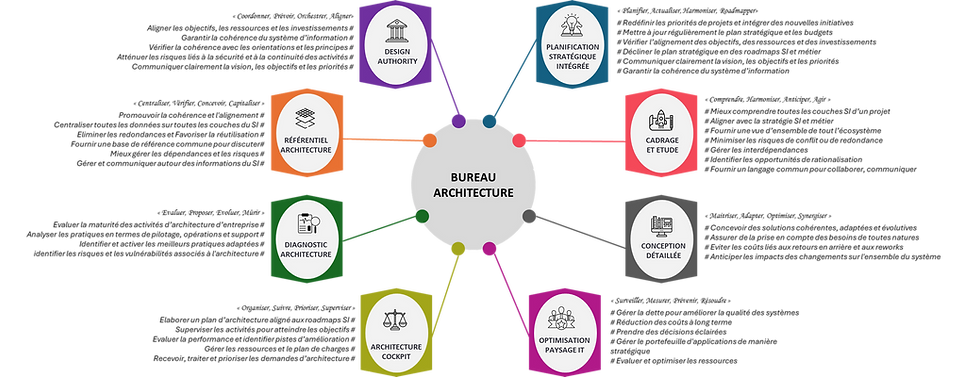How to avoid the zombie initiative effect in digital roadmaps
- Gabriel Amine Ghalleb
- Jun 24
- 11 min read

The problem: “undead” projects that refuse to die
In many organizations, some digital projects take on the form of the walking dead : they wander the halls of the company, consuming resources, but leading nowhere. These "zombie initiatives" continue to move forward as best they can, sucking up time, budget, and energy without ever delivering the expected value. While these useless projects gobble up resources, other real innovations lack the support to see the light of day. The result? A portfolio of digital initiatives cluttered with useless programs that hinder the company's overall digital transformation.
Why do these zombie projects survive? Often because they are difficult to complete permanently . An emotional attachment has been created around them – “we’ve already invested so much, maybe one day it will finally work…” It is generally easier to identify a zombie project than to destroy it: many people do not dare to give up on a project in the vague hope that it will one day succeed in some way. This fear of failure and waste leads organizations to tolerate the intolerable : worthless initiatives that continue to tie up teams and budgets. Before looking at how to fix this, let’s explore what these digital zombies look like through some concrete examples.

Zombies on the roadmap: examples of useless initiatives
To better understand the zombie effect, let's imagine some scenarios inspired by real cases:
The AI Project Without a Use Case : Under pressure from the artificial intelligence craze, a company launches an ambitious machine learning project… without a clear business objective. Data scientists develop sophisticated algorithms, but no one really knows what concrete problem to solve. As the months go by, the POC (Proof of Concept) drags on, with no tangible production launch in sight. Yet this AI project continues to consume budget and time, even though 85% of AI projects miss their business objectives according to Gartner . It's the very prototype of the zombie initiative: a high-tech project launched to "do what everyone else does," with no identified benefit, which lingers in a living-dead in-between.
The Endless CRM Migration : A large group decides to migrate its entire CRM system to a new platform, supposedly intended to revolutionize customer relations. The project, scheduled for 12 months, lasts 36, then 48… Teams change, specifications drift, end users become discouraged. Yet, it's impossible to stop the initiative after so much investment. Executives continue to inject resources "to finish the job," without realizing that the world has evolved around them. This scenario is not uncommon— more than one in two CRM projects fails to achieve its objectives, according to some studies. Here, the zombie initiative takes the form of a redesign project that never ends, stuck in technological and organizational limbo .
The product repository disconnected from the business : Another common example is a project to implement a new product repository (PIM/MDM). IT deploys a brand-new tool to centralize all product data, convinced it will provide a miracle solution. But the business teams weren't involved upstream: the defined categories, attributes, and workflows don't match the realities on the ground. As a result, no one really adopts the system, and the old Excel files continue to reign supreme. Officially, the project isn't "stopped"—it's still on the digital roadmap—but in practice, it's undead . It consumes a few resources (minimal maintenance, software licenses) without providing any value, due to a lack of engaged users.
These examples illustrate the various forms that zombie initiatives can take. Each differs in context, but all share a common symptom: they exist by inertia , without any positive impact, sometimes even in full view of everyone, but without any courageous decision being taken to stop them.

How to detect a zombie initiative? (Detection grid)
How can you spot projects that have become zombies in a busy digital roadmap? Here's a detection grid that includes visible symptoms , weak signals , and organizational behaviors that indicate a project is undead.
Obvious symptoms
Lack of concrete results : The project has been going on for months (or even years) without usable deliverables or measurable success. No internal success stories have emerged, and KPIs remain disappointingly flat or empty. At steering committee meetings, project presentations are full of slides on "the next phase" or theoretical arguments, but struggle to demonstrate tangible achievements.
Unclear purpose or scope : If no one can clearly explain the project's business purpose or the exact problem it solves, red flag. Poorly defined scoping from the outset often results in a zombie project. A telltale sign is when the project's purpose constantly shifts through discussion—proof that it lacks a clear " north star."
No longer an active user or sponsor : The initial sponsor has left the company or disengaged, and no other executive is truly leading the project. Similarly, end users—if they exist—are no longer consulted or involved. An orphaned project on the business side, left in the sole hands of the IT department, is an ideal zombie candidate. For example, discovering that a tech team has been working on an application for months while the executive who requested it left weeks ago is typical of a zombie project.
Consistently exceeding budgets and deadlines : Of course, not all late projects are zombies, but a project that keeps getting delayed with no end in sight should be cause for concern. When each new deadline is missed and immediately replaced by another equally unrealistic one, it's a sign that the project isn't moving forward and may already be dead inside .
Weak signals
No one is asking the question “Why this project?” : Paradoxically, one of the weak signals is silence. For fear of offending or out of habit, no one dares to ask “By the way, why are we doing this project again?” This lack of questioning may indicate that we are dragging a ball and chain that we no longer dare to discuss openly. When alignment with the strategy is not obvious but the subject becomes taboo, be careful.
Demotivated or Minimized Team : Observe the project team's state of mind. If top talent has been reassigned elsewhere and only a core team remains, keeping the project on life support, it's a sign that the initiative is no longer a priority. Gradually withdrawing resources without formally shutting down the project often leaves a zombie running amok.
Constant pivoting of scope : The project has changed its name, objectives, or underlying technology three times since its launch. There is constant pivoting in the hope of "finding the magic formula" that will justify continuing. These frequent changes of direction often reflect a lack of initial vision and a flight forward to avoid admitting failure.
Revealing organizational behaviors
Leaders avoid talking about it : In strategy meetings, as soon as the zombie project is mentioned, unease sets in. The topic is quickly dismissed, or worse, removed from the agenda. This silence reflects collective discomfort with an initiative that everyone knows is floundering, but no one dares to declare dead. A truly useful project, on the other hand, would generate active questions and interest.
“We can't stop it, we've already invested too much” : This little phrase is the mantra of the sunk cost syndrome . If you hear it, danger: it's precisely this reasoning that keeps zombies on artificial life support. Continuing just because you've already paid a lot is a classic mistake and a common organizational behavior in zombie projects.
Multiplication of redundant initiatives : An organization that doesn't manage its portfolio well can create unnecessary duplication—for example, two different teams each unknowingly developing a similar tool. These uncoordinated parallel projects often end up as zombies.
.
In short, a project is likely a zombie if it lacks vision, sponsorship, results, and alignment, yet persists due to inertia. Once these symptoms are identified, it's time to look at the causes : what in the project or organizational management allowed these zombies to appear?

Where do zombies come from? Common mistakes behind them
No leader deliberately wants to launch a project that is doomed to wander aimlessly. Zombie initiatives are most often the result of management or governance errors, combined with human bias .
Here are some common causes:
Unclear or sloppy initial framing : This is the original sin of many failed projects. A project launched on the basis of a buzzword ( “We need AI / Big Data / blockchain” ) rather than a concrete business need starts with an almost insurmountable handicap. Without a clear vision, without a specific use case validated with the field, the project will search for a goal throughout its existence – ideal ground for becoming a zombie. Conversely, poorly defined, unmeasurable objectives, or a neglected business case leave the project without a compass from the start.
Steering detached from the field : Once the project is launched, a classic error is purely theoretical steering. If decisions are made solely by steering committees, based on watered-down reports, without ever confronting the reality on the ground, we are heading for disaster. Warning signals (skeptical users, product defects, inadequacy of business processes) are not reported to the decision-makers. The latter continue to manage "on a plan," detached from the concrete, and prolong a project that is already clinically dead from the users' point of view.
Lack of product governance : Modern agile approaches emphasize the concept of a Product Owner or product manager, who ensures value for the end user. If a digital initiative is managed as a purely IT project without an identified product manager, there's a strong chance it will drift. Without a usage-centric "product" vision, the project can get bogged down in technical developments that are far removed from the real need. The absence of product governance also results in a lack of regular user feedback and prioritization based on the value created, which leaves the project open to dragging on without delivering.
No project kill governance : Many organizations simply do n't have an established mechanism for killing a project midstream. Once a project is on the roadmap, there's a tendency to see it through to completion, no matter the cost, short of a blatant disaster. There's a lack of clear decision gates where people objectively assess whether the project should continue, pivot, or stop. Without this safety net, low-value projects can thrive indefinitely. Furthermore, success metrics are sometimes nonexistent or inadequate: how do you stop a project officially "green" on your dashboard, even if everyone feels it's useless? Poorly designed or purely technical KPIs can mask the reality of the lack of value.
Failure-avoidance culture : Finally, the cultural dimension is crucial. In some companies, failure is taboo . Admitting that a project hasn't worked is seen as an admission of weakness, or even professional misconduct. This climate pushes teams to artificially prolong projects that have gotten off to a bad start, rather than addressing a thorny issue. Everyone hopes to avoid questioning by continuing to push the machine a little further. In addition, psychological commitment plays a role: we convince ourselves that "if we persevere a little longer, it will eventually pay off." This lack of safety to say "stop" directly fuels the graveyard of zombie projects.
Understanding these mistakes helps you prepare countermeasures. Fortunately, there are concrete approaches to avoid or eliminate zombies from your digital roadmap.

Exorcising zombie projects: strategic and operational levers
The good news is that zombie initiatives can be prevented , and even eliminated when they arise, by applying a few rigorous governance and management principles.
Here are some strategic and operational levers to protect yourself from the invasion of undead projects:
Co-scoping with the business from the start : Involve the business teams in defining the project from the very beginning. Co-construct the framework (objectives, use cases, success indicators) with those who will use or benefit from the solution. This ensures that the project meets a real need and creates mutual commitment. A co-scoping project will be much less likely to become a zombie project, because its usefulness is validated from the outset by the field.
Continuous value analysis and business case review : Don't think of the business case as a fixed document tucked away in a drawer. Implement a regular review of the value expected and delivered by the project. At each key stage (end of sprint, end of phase), ask yourself: What value have we delivered so far? Do the initial assumptions still hold? If the answer is disappointing, have the courage to recalibrate or stop before wasting more. This value analysis must be factual (usage KPIs, interim ROI, user feedback). It can be based on tools, for example, by dividing the project into stages with success criteria to be met to move on to the next one. The idea is to introduce frequent viability checkpoints to avoid over-exertion on a project that is in poor shape.
Effort-Impact-Budget Matrix and Rigorous Prioritization : Faced with a list of digital initiatives, arm yourself with an Effort/Impact/Budget matrix to prioritize intelligently. This visual tool positions each project according to the expected impact (benefits, business value) and the required effort (cost, complexity). Ruthlessly discard “low impact – high effort” initiatives : these are potential zombies. By using these prioritization methods, you avoid overlooking mediocre ideas that will then siphon off resources.
Portfolio mapping and strategic alignment : Take a step back and look at your digital project portfolio. Map each initiative against the company's strategic objectives or the pillars of your roadmap (e.g., operational excellence, customer growth, new business models, etc.). A project that does n't align with the identified strategic axes should trigger a serious review—either a legitimate connection is found, or it may not exist. This portfolio mapping exercise also helps identify duplication and dispersion .
Flash reviews and regular project audits : Establish a quick portfolio review ritual (quarterly, biannually) where each initiative is concisely reviewed for its progress and expected contribution. The goal is not to police, but to detect projects that are out of step early . Perhaps invite an external perspective (a peer from another entity, a central PMO, etc.) to challenge with a fresh eye: “What has this project really contributed over the last 3 months? How is adoption progressing?” These flash reviews can serve as a decompression chamber to identify latent zombies and recommend actions (recovery or termination) before it is too late. Similarly, don't hesitate to organize flash “post-mortems” on projects that have recently stopped or delivered without success: learning lessons from them avoids recreating a similar zombie later.
Conditional budget freeze and exit clauses : For large, high-risk programs, implement budgetary guidelines . For example, allocate the budget in conditional tranches: “we release the next tranche if and only if such and such an intermediate result is achieved by then.” This conditional freeze requires the project to prove itself step by step . If the conditions are not met, funding automatically stops pending a recovery decision. Similarly, introduce explicit kill criteria into your roadmaps: for example, “if the project has not reached X active users within 6 months, we stop.” These safeguards make stopping a project less subjective and less linked to individual courage – it is pre-negotiated in the plan. This helps overcome bureaucratic inertia by providing an objective basis for burying projects that do not deliver the promised value .
Culture of the right to fail and learning : Finally, perhaps the most decisive lever is cultural . It involves transforming the approach to failure within the company. Establishing a “zombie amnesty” can be a salutary approach. This consists of announcing that killing a useless project will not be penalized, on the contrary – teams who have the courage to declare that an initiative is not having the expected impact should be valued, not blamed. Why not celebrate these difficult decisions? This change in mindset creates an environment of psychological safety where everyone dares to raise problems and stop the costs in time. Quickly, the organization gains maturity: failures are no longer hidden, they are addressed and something learned from them.
By combining these levers – co-framing , value-driven management , strict portfolio governance , regular reviews and a culture open to learning – you give yourself every chance of preventing zombie projects from proliferating. And if they do, you will have the tools to identify and neutralize them quickly.

Conclusion — Courage, clarity, framework
Avoiding zombie projects isn't a question of a miracle method: it's a discipline . It's the discipline of framing with clarity, of steering by real value, of knowing how to say stop at the right time. And it's also a state of mind : valuing honesty, not fearing stopping, learning from what doesn't work.
CDOs, CTOs, and architects must embody this demanding stance. A powerful roadmap is a living roadmap: without zombies, but filled with useful, aligned, and committed projects. Nothing more. Nothing less.



Comments